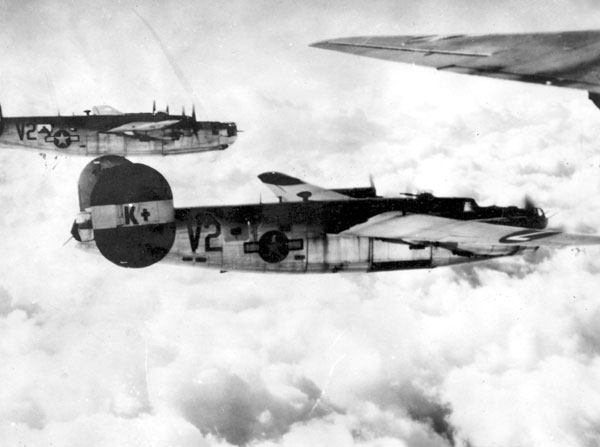B-24s flying |
 |
 |
B-24s flying |
 |
 |
To The Edge of North America
We rumbled down the McCook runway for the last time on May 2nd. We didn't go far, just across Nebraska to Lincoln where I'd taken basic training a little more than a year earlier. Here we received further instructions directing us to other air bases in the eastern U.S. On the 10th we lifted off from a field in New Hampshire and headed north. Once past the St. Lawrence we flew low over the wintry wastes of eastern Canada.
Five hours from New Hampshire we set down at Goose Bay, Labrador. Snow was piled high on both sides of the runway, a sign of what was to come on the morrow. A windy snowstorm held us here for a day. Of course, we expected snow, cold, and wind at this outpost, but who would expect "tropical butter" in a mess hall in the frozen north? This non-spreadable spread consisted of beeswax whipped into butter so that it wouldn't melt in the tropical or desert sun. In Labrador you needed a sharp knife to whittle shavings off the block.
To Iceland
On the 12th we flew eastward, following a 150-mile long series of inlets and bays leading to the edge of the continent, then, leaving our last checkpoint, set a northeasterly course for Reykjavik, Iceland. From readings through the driftmeter on icebergs and whitecaps on the sea below, I could calculate the relative wind.
Soon the ceiling lowered. We climbed above the cloud layer where I used a sextant to fix our position. Then the heavens were shrouded by higher clouds. Woody took the plane up so I could get another fix, but the clouds kept piling up; so we came down and flew between the cloud layers. A month earlier in similar conditions flying with Colonel Helton over Texas, dead reckoning and bearings on radio stations had kept us on course. However, unlike Texas, radio stations are not scattered over the North Atlantic. As we passed far south of the tip of Greenland a radio beacon helped me determine our longitude with hundreds of miles yet to go.
I'd found that the high- and low-level winds differed greatly. The best I could do was to average these winds for our altitude and, using our indicated airspeed and compass direction, continue to plot our course by dead reckoning. As the hours crawled by with no break in the clouds above or below, I wondered why they called it "dead reckoning". Iceland is a fair-sized island of nearly 40,000 square miles, about the size of Kentucky, but that day it seemed to be a small chip floating in a monstrous tub of frigid water.
Eventually, my radio compass picked up the signal from the field near Reykjavik. I gave the crew an estimated time of arrival as we started to home in on the broad fan of the beam, flying a curving instead of direct course. The moment when we should be seeing land found us in a snowstorm still over the icy ocean. Every minute thereafter was a time of concern. Finally, eight hours out of Goose Bay, through breaks in a curtain of snow we glimpsed the dark grayness of the island coast. More than a half hour after my announced ETA we put down on the long-sought-for airfield.
The Iceland airbase, Keyflavik, was a miserable place. Our quarters were cold, damp, and dirty. Dog turds were on my cot. Mess hall food was so unappetizing that I cut open my K rations, a small box of emergency food: crackers, potted meat, and candy. The base was staffed by dejected old soldiers, probably in their thirties. They saw off young men flying eastward into action and young men flying westward home. A tale told was that most of the cadre had come from stations in England. They had been put on a ship headed westward, making them think they were going home; instead they were dumped in Iceland as permanent personnel. They were virtually confined to the base, because the people of nearby Reykjavik would have little to do with Americans. The U.S. had seized the island to forestall the Germans, but the Icelanders would have preferred to be left alone.
To Wales
After another gloomy day of snow and fog, the clouds thinned. We were airborne again. No need to use the radio compass this sunshiny day. Besides, we were warned that the Nazis put out false beams to lure our planes to occupied Norway. We made landfall near Stornoway on the Isle of Lewis off the northwest coast of Scotland. Then we banked to the right and coursed southward over the Irish sea. Below us sailing in the same direction was an impressively long convoy of scores of ships. An oddity: we passed through a puffball cloud that cracked like a pane of glass and for a second obscured with rime ice the windows from which Mike and I were viewing Europe for the first time.
After nearly six hours of flying , we touched down in the early afternoon of May 14th on a field near the village of Valley on the Isle of Anglesey in westernmost Wales. Our trans-Atlantic passage from the U.S. had taken 19 hours in three days of flying plus two days grounded by weather.
Back to Navigating Through World War II Home Page